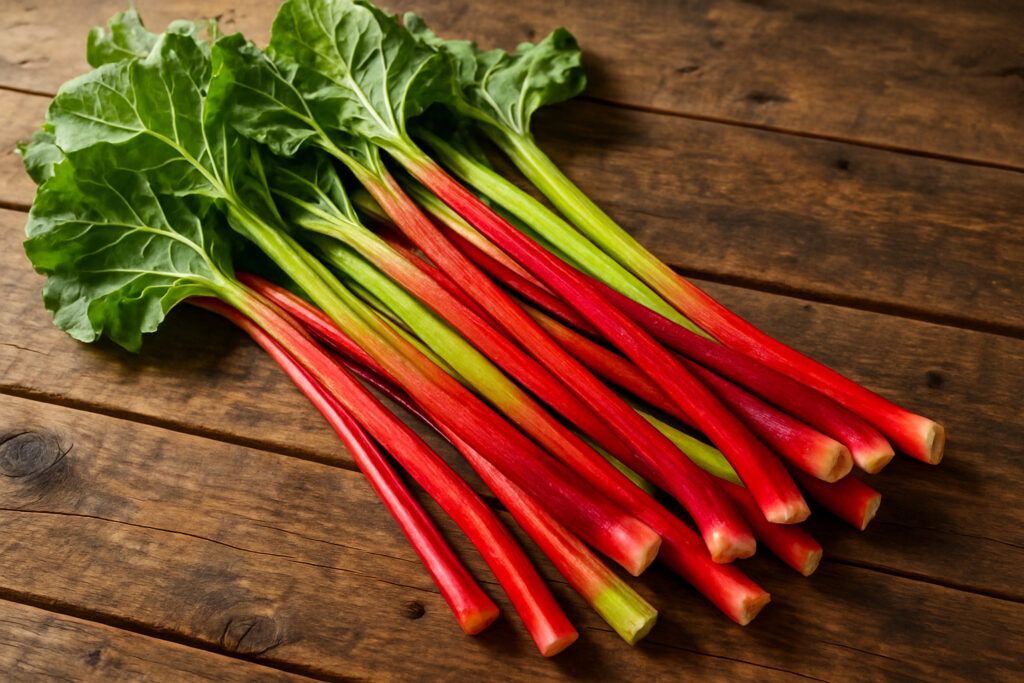Why Rhubarb Deserves a Place in Every Culinary Trip
Rhubarb might look like red celery, but this tart perennial vegetable has been captivating taste buds for centuries. Whether you’ve spotted those vibrant crimson stalks at a farmers market in New York City or encountered rhubarb in a traditional British pub dessert, this unique ingredient offers endless culinary possibilities.
Quick Rhubarb Facts:
- What it is: Edible leaf stalks of the Rheum plant – technically a vegetable but used like a fruit
- Edible parts: Only the stalks – leaves are toxic and must be discarded
- Season: April through June in most temperate climates
- Flavor: Intensely tart and sour, requiring sweetening for most palates
- Uses: Desserts, jams, savory dishes, cocktails, and traditional medicine
This remarkable plant has traveled from ancient Chinese medicine cabinets to Yorkshire forcing sheds to American pie plates. Raw rhubarb contains 94% water and delivers a mouth-puckering punch of malic acid that transforms into jammy sweetness when cooked with sugar.
For the adventurous food traveler, rhubarb opens doors to regional specialties – from Finland’s traditional sima to the prized “champagne rhubarb” grown in candlelit sheds across northern England. But here’s the catch: those gorgeous umbrella-like leaves contain dangerous levels of oxalic acid and must never be eaten.
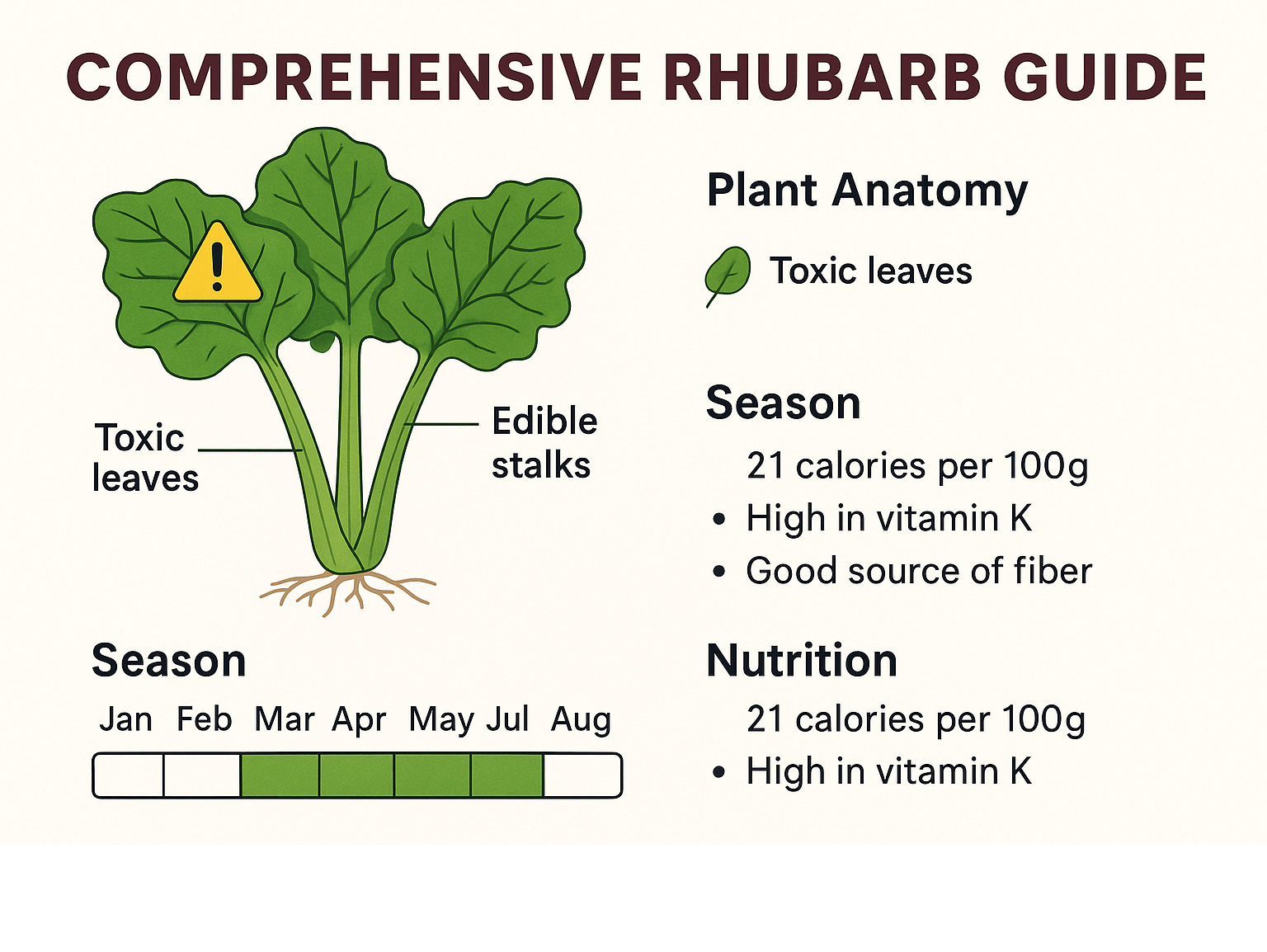
What Exactly Is Rhubarb?
Rhubarb is actually a vegetable, not a fruit! Despite showing up in countless strawberry pies and sweet desserts, rhubarb belongs to the Polygonaceae family and goes by the scientific name Rheum rhabarbarum.
What we eat are the thick, fleshy leaf stalks called petioles. Think of them as nature’s sour candy – packed with tartness that transforms into jammy sweetness when cooked. But here’s the crucial part: those gorgeous, umbrella-like leaves are completely off-limits. They contain dangerous levels of oxalic acid and anthrone glycosides that can make you seriously ill.
The name “rhubarb” tells quite a travel story. It journeyed through French “rubarbe” and Medieval Latin “rheubarbarum” before landing on the Greek “Rha barbaron,” which means “foreign plant from the Rha River.” This reflects how precious this plant was along ancient trade routes, as documented by botanical researchers at Kew Gardens.
In 19th-century America, rhubarb earned the charming nickname “pie plant” because that’s exactly what people used it for. The U.S. government officially classifies rhubarb as a fruit for regulatory purposes, even though botanically it’s a vegetable.
Rhubarb Varieties & Flavor Profiles
Red-stalked varieties like Canada Red deliver deep crimson stalks with surprisingly sweet, tender flesh. Crimson Red keeps its bright color throughout and has less stringy texture. MacDonald offers reliable red color with a perfect sweet-tart balance.
Green-stalked varieties pack their own punch. Victoria is incredibly tart and robust, perfect when you want that mouth-puckering intensity. Valentine surprises people with its pink-red stalks and exceptional sweetness.
Then there’s Champagne rhubarb – grown in complete darkness in Yorkshire forcing sheds, creating pale pink stalks so tender they practically melt in your mouth.
Rhubarb in Global Cuisines
Rhubarb’s journey around the world reads like a culinary trip. In ancient China, dating back to 2700 B.C., people valued rhubarb root as powerful medicine. British cooks developed “forcing” – growing rhubarb in heated, pitch-black sheds to create delicate “champagne rhubarb.”
Nordic countries created sima, a lightly fermented, mead-like beverage perfect for spring celebrations. In Persian kitchens, rhubarb takes a savory turn in rich lamb stews, where its natural acidity cuts through the meat’s richness.
Nutrition & Health: Benefits and Safeguards
Rhubarb stalks pack impressive nutrition into surprisingly few calories. At just 21 calories per 100 grams, this tart vegetable delivers more nutritional value than many fruits we consider “healthy,” according to the USDA’s nutrition database.
The star player is vitamin K – one serving provides nearly a quarter of your daily needs. Vitamin C comes in second, supporting your immune system with about 9% of what you need daily. Those crimson stalks contain 94% water, making them incredibly hydrating, plus they deliver solid fiber to keep your digestive system happy.
Red varieties contain more antioxidants than their green cousins, thanks to those beautiful pigments. The nutrition story gets dangerous when we talk about leaves, though. While stalks contain negligible amounts of oxalic acid, the leaves concentrate this compound at toxic levels.
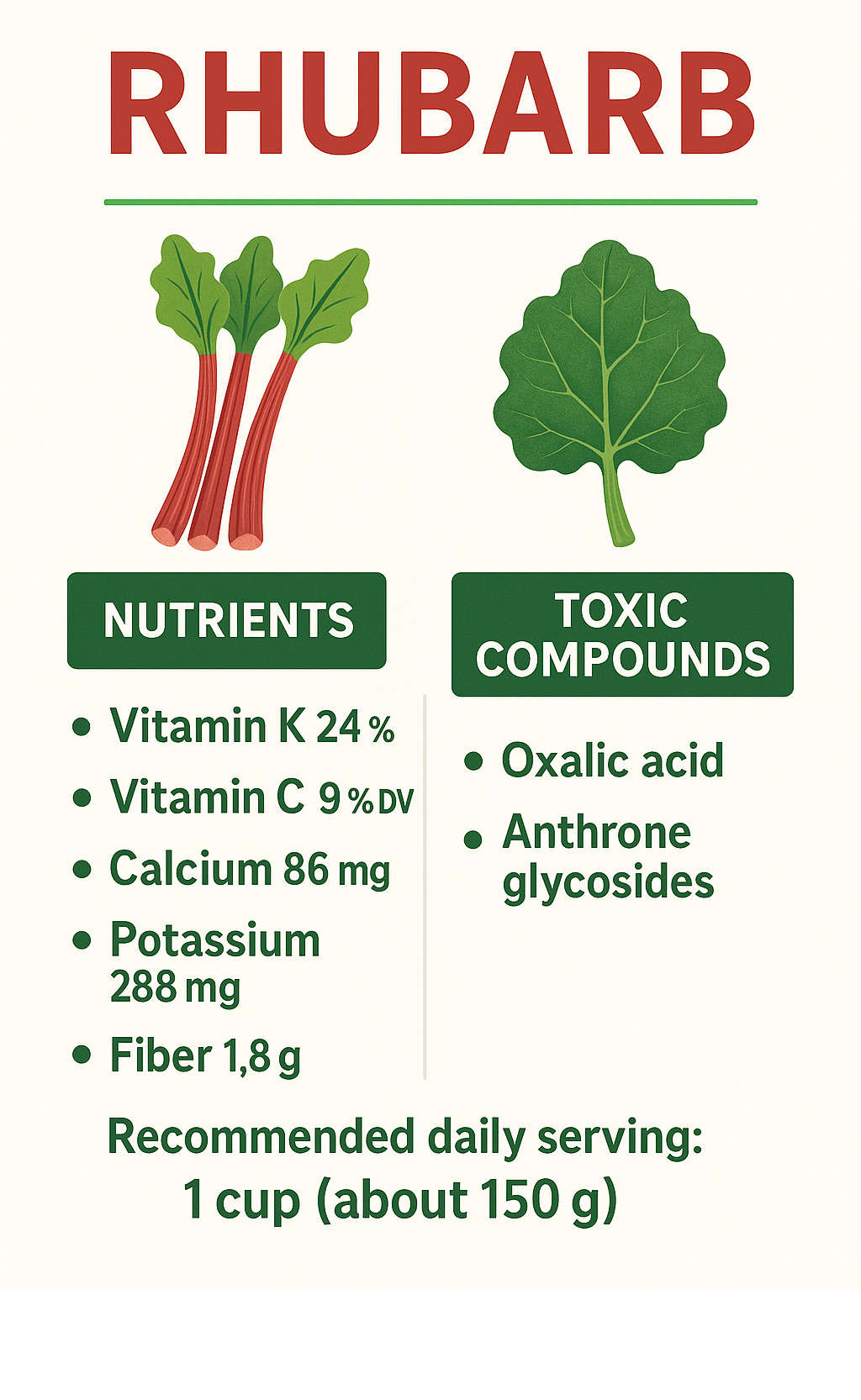
How Much Rhubarb Is Safe?
You can enjoy the stalks without worry – there’s no upper limit for healthy people. Most recipes call for half a cup to one cup of cooked rhubarb per serving, which is perfectly safe.
The leaves tell a different story. Even smaller amounts can cause serious kidney problems and severe stomach pain. When preparing fresh rhubarb, immediately cut off and discard every bit of leaf material.
Potential Health Uses
Traditional Chinese medicine has prized rhubarb root for over 4,000 years. Modern research suggests rhubarb root extracts might support kidney function, though this requires medical supervision. The most proven medicinal use combines rhubarb extract with sage in topical creams for cold sores.
Growing, Harvesting & Storing Rhubarb
Rhubarb is surprisingly forgiving and can keep producing those tart stalks for 10 to 15 years with minimal fuss. This hardy perennial thrives in cooler climates (USDA zones 3-8) because it needs chilly winter months below 40°F to reset and produce well.
The plant prefers well-draining, fertile soil with a pH between 6.0 and 7.0. Unlike whipping up our alfredo sauce recipe for instant satisfaction, rhubarb requires patience. You’ll need to resist harvesting the first year, go easy in year two, then enjoy abundant harvest starting in year three.
Starting Rhubarb at Home
Start with crowns rather than seeds for reliable results. Plant crowns about 2 inches below the soil surface with buds pointing up. Give each plant 2 to 4 feet between plants. Soil preparation is crucial – dig generous holes and work in plenty of compost.
Division every 3 to 4 years keeps plants vigorous. When plants are dormant, dig up crowns and split them with a sharp spade.
Harvest Timing & Techniques
The magic rhubarb harvest window runs from April through June. Look for stalks that are 12 to 18 inches long with good diameter. Don’t cut the stalks – instead, grasp them at the base, then twist and pull upward.
Always leave at least 2 to 3 stalks per plant so it can continue growing strong. Remove flower stalks immediately to maintain stalk production.
Long-Term Storage Hacks
Fresh rhubarb stalks keep in your refrigerator for 2 to 3 weeks in perforated plastic bags. Freezing rhubarb couldn’t be simpler – wash and cut stalks into half-inch pieces, pack into freezer bags, and you’re good for up to 12 months.
Cooking with Rhubarb: Classic & Creative Uses
Rhubarb transforms from mouth-puckering stalks into sublime culinary creations with the right techniques. The secret lies in understanding its intense tartness and knowing how to balance that natural acidity.
Traditional rhubarb desserts like crisps and crumbles remain crowd-pleasers because they’re easier than pie while delivering equally satisfying results. The fruit’s natural pectin content makes it perfect for jams and jellies.
Rhubarb shines in savory applications too. Its bright acidity cuts through rich meats beautifully, making it perfect for chutneys. Quick pickles with lemongrass and ginger bring an Asian twist.
One professional trick: add 1/4 teaspoon baking soda to rhubarb crisps to neutralize excess acidity without loading up on extra sugar.
The best rhubarb pairings include strawberry for perfect sweet-tart balance, ginger for warming spice, vanilla to mellow sharpness, elderflower for floral notes, and cardamom for exotic complexity.
Quick Weeknight Rhubarb Recipes
This 3-ingredient compote delivers restaurant-quality results: combine 1 pound rhubarb with 1/2 cup sugar, 1 vanilla bean, and a pinch of salt. Simmer until jammy – about 8 to 10 minutes.
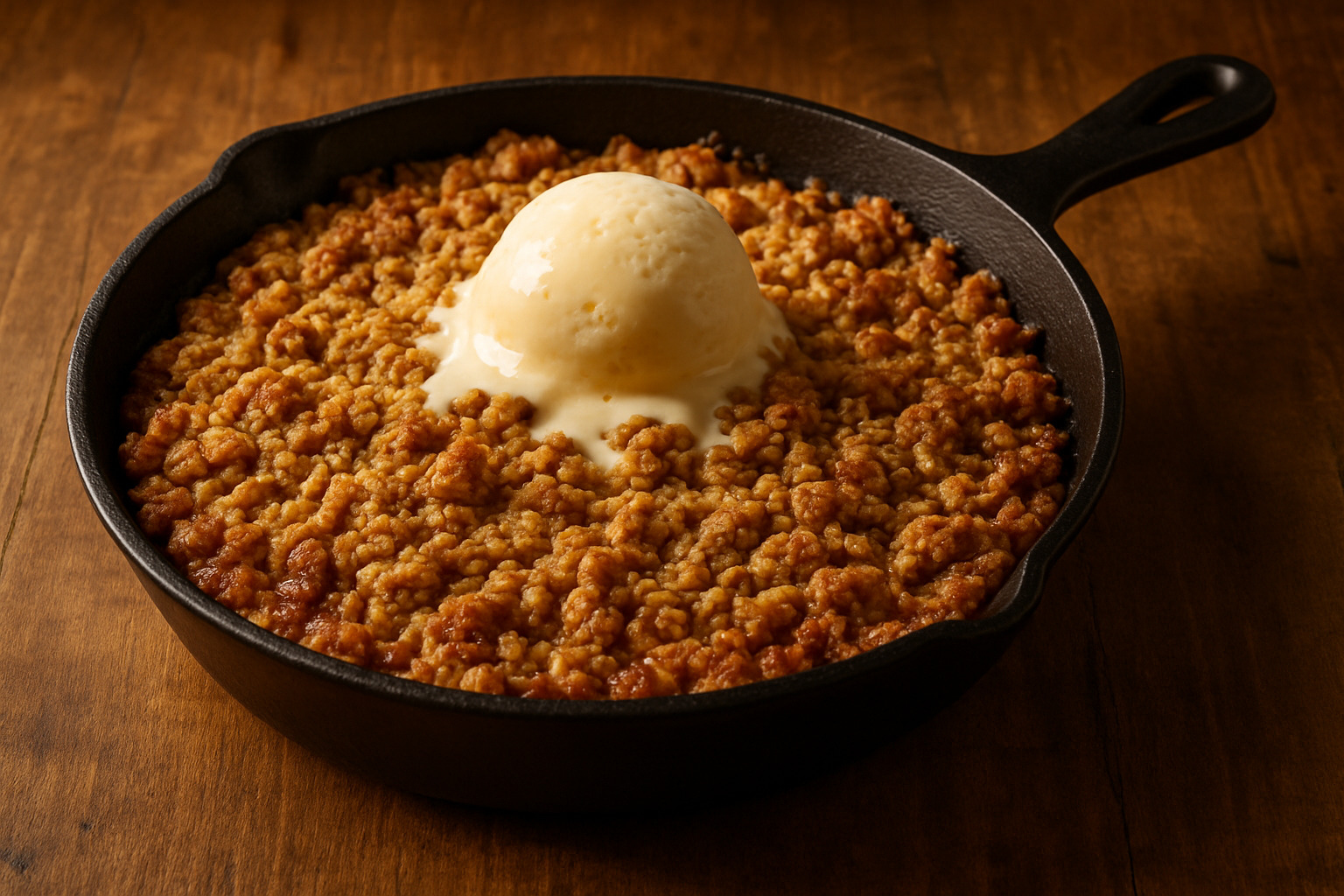
The simple skillet crisp pictured above represents everything wonderful about weeknight rhubarb cooking. This one-pan wonder requires no special equipment and delivers comfort in just 30 minutes.
Show-Stopping Desserts & Drinks
Strawberry-rhubarb pie remains the ultimate rhubarb showcase. The secret? Macerate both fruits with sugar and tapioca before assembling to prevent soggy bottoms.
Rhubarb kuchen brings German sheet-cake tradition with spectacular results. The cocktail possibilities include a rhubarb sidecar with brandy and homemade rhubarb syrup, perfect alongside our bundt cake recipes.
Preserving Rhubarb Year-Round
The fleeting nature of rhubarb season makes preservation essential. Freezing stands out as the most foolproof method – simply wash, chop, and pack straight into freezer bags. The natural acidity preserves both color and texture for up to 12 months.
Water-bath canning works wonderfully for rhubarb packed in light sugar syrup. The high acid content makes it safe for boiling-water processing. Dehydrating transforms rhubarb into concentrated flavor bombs perfect for granola or trail mixes.
DIY Rhubarb Shrub & Bitters
Rhubarb shrubs represent the perfect marriage of sweet, sour, and funky flavors. Simmer two pounds chopped rhubarb with two cups sugar until jammy. Strain, then whisk in one cup apple cider vinegar. The finished shrub keeps refrigerated for six months.
Homemade rhubarb bitters require patience but deliver extraordinary results. Steep chopped rhubarb in high-proof spirits for two to four weeks, then strain and age.
Gift-Ready Jams & Chutneys
Homemade rhubarb jam showcases the natural pectin that creates perfect gel without commercial thickeners. Cardamom brings aromatic warmth, fennel adds subtle licorice notes, while fresh ginger provides heat and brightness.
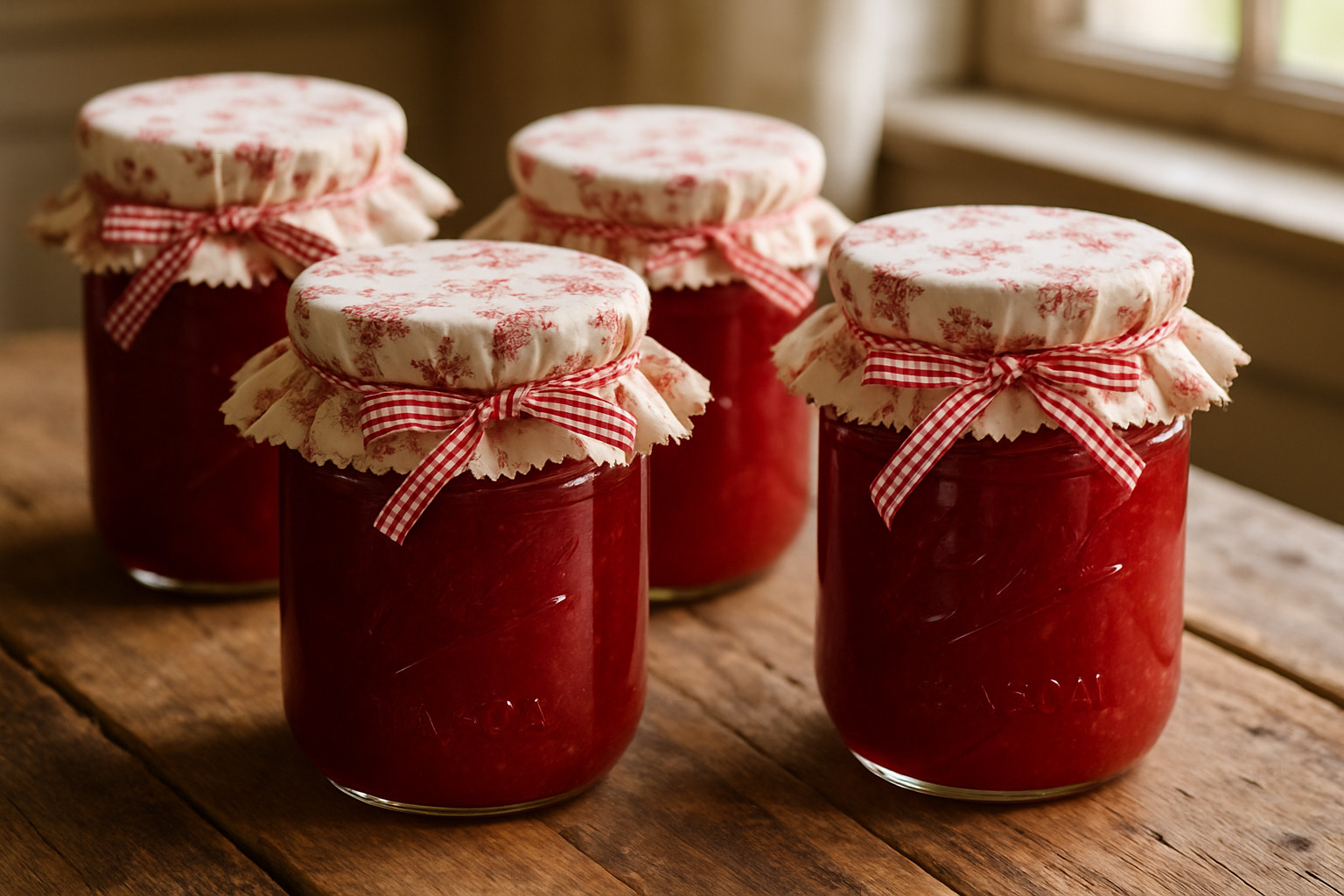
Always follow tested recipes when canning for safety. The pH levels need to stay within safe ranges to prevent dangerous bacteria growth.
Frequently Asked Questions about Rhubarb
Is rhubarb a fruit or a vegetable?
This question stumps even experienced cooks! Rhubarb is botanically a vegetable since we’re eating the leaf stalks (called petioles) of the plant. But here’s where it gets interesting – the U.S. government legally classifies rhubarb as a fruit for trade and regulatory purposes.
Why the confusion? It all comes down to how we actually use rhubarb in our kitchens. Since it almost always appears in pies, jams, and desserts alongside strawberries and other fruits, the legal classification follows culinary tradition rather than botanical science.
Think of it like the famous tomato case – botanically a fruit, but legally considered a vegetable for trade purposes. The practical answer? Rhubarb acts like a fruit in your recipes, even though technically it’s a vegetable. This quirky classification actually makes perfect sense when you’re standing in your kitchen deciding whether to make a strawberry-rhubarb pie or add it to your vegetable garden.
Can I eat rhubarb leaves in any form?
Absolutely never eat rhubarb leaves – this cannot be emphasized strongly enough. The leaves contain dangerous concentrations of oxalic acid (about 0.5% by weight) plus toxic compounds called anthrone glycosides that can cause serious harm.
Even small amounts of rhubarb leaves can trigger nausea, difficulty breathing, and kidney damage. Tragically, a 4-year-old child died from oxalic acid poisoning after eating rhubarb leaves, highlighting just how serious this risk is.
When you’re preparing rhubarb, immediately cut off and discard all leaf material. Don’t try cooking them, drying them, or using them in any form – there’s no safe way to consume rhubarb leaves. The good news? They break down safely in compost piles as the toxic compounds decompose naturally.
If you have children or pets, dispose of the leaves where they can’t access them. Never leave them lying around the garden or kitchen where curious little ones might take a taste.
How do I know when rhubarb is in season?
Rhubarb season brings pure excitement to food lovers, typically running from April through June in most temperate climates. The timing varies depending on your location and local growing conditions, but there are reliable signs to watch for.
Your local farmers market provides the best seasonal indicator – when fresh rhubarb stalks start appearing at multiple vendors, you know the harvest has begun. This is usually when you’ll find the best quality and lowest prices too.
In grocery stores, peak availability and competitive pricing signal rhubarb season. You’ll notice displays featuring fresh stalks prominently, often alongside strawberries since they’re natural partners.
Look for stalks that are 12-18 inches long and at least 3/4 inch in diameter. They should feel firm and crisp with bright color – either deep red or vibrant green depending on the variety. Avoid any stalks that seem wilted, soft, or overly stringy, as these indicate the rhubarb is past its prime.
Some specialty markets in New York City and other major cities carry hothouse or “forced” rhubarb earlier in the season. This delicate, pale pink variety costs more but offers incredibly tender stalks perfect for special occasions. However, field-grown rhubarb during peak season delivers the best value and most robust flavor for everyday cooking.
Conclusion
Rhubarb offers food enthusiasts a remarkable culinary journey that weaves together ancient history, modern innovation, and pure seasonal joy. From its precious beginnings along the Silk Road to today’s craft cocktail menus in New York City, this extraordinary vegetable continues to surprise and delight.
Whether you’re nurturing your own perennial patch, dreaming of visiting Yorkshire’s legendary forcing sheds, or simply staring at that bundle of ruby stalks from the weekend farmers market, rhubarb rewards every bit of curiosity with unforgettable flavors.
The true beauty of rhubarb lies in its incredible versatility. It feels equally at home in grandma’s strawberry-rhubarb pie, an neat French tart, a Persian lamb stew, or a handcrafted cocktail shrub. This adaptability makes it perfect for modern food lovers seeking authentic local flavors.
For those ready to start their own rhubarb journey, this hardy perennial rewards patience like few other plants. Plant those crowns this spring, tend them with care, and you’ll be harvesting delicious rewards for decades to come.
Rhubarb represents something deeper than just another ingredient – it’s a living connection to seasonal eating, time-honored preservation methods, and the simple pleasure of changing something wonderfully sour into something beautifully sweet.
Ready to start on your own culinary trips? Find more about global food experiences, seasonal ingredients, and dining trends at The Dining Destination, where we celebrate the ingredients and traditions that make food travel so rewarding.

